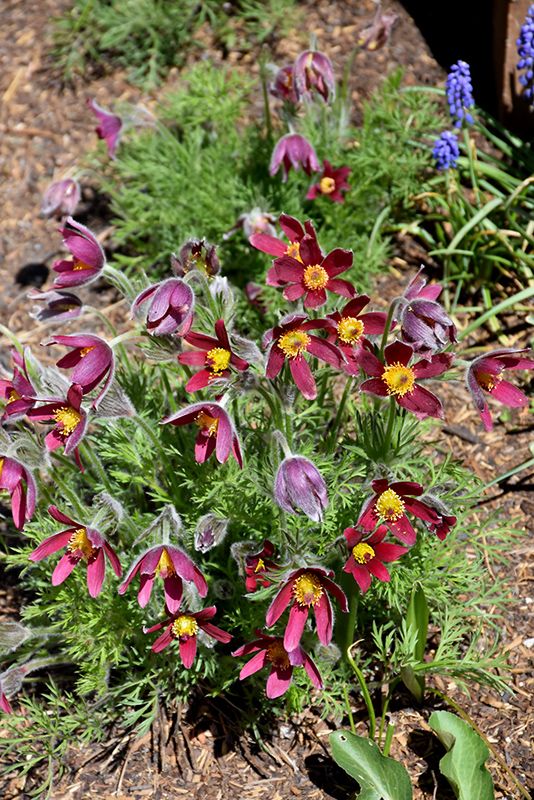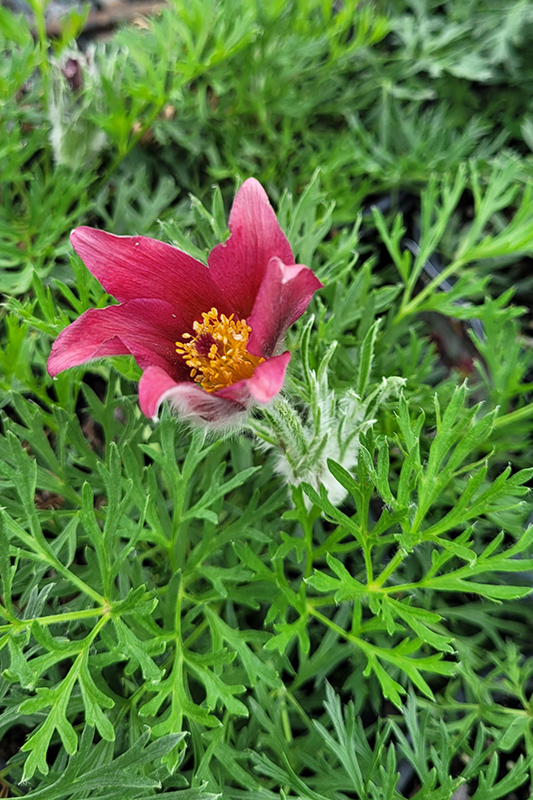Red Pasqueflower Pulsatilla vulgaris 'Rubra' Plant Height: 8 inches Flower Height: 12 inches Spacing: 10 inches
Sunlight:
Hardiness Zone: 2 Other Names: Prairie Crocus Description: A red form that produces a beautiful cluster of furry buds followed by large wine-red flowers in the spring over the silvery fern-like foliage; an ideal rockery plant that improves with time if left alone Ornamental Features Red Pasqueflower has crimson cup-shaped flowers with yellow eyes at the ends of the stems from early to mid spring, which emerge from distinctive dark red flower buds, and which are interesting on close inspection. The flowers are excellent for cutting. Its deeply cut ferny compound leaves remain silver in color throughout the season. The silver fruits are carried on plumes from early summer to early fall. Landscape Attributes Red Pasqueflower is an herbaceous perennial with a mounded form. It brings an extremely fine and delicate texture to the garden composition and should be used to full effect. This is a relatively low maintenance plant, and is best cleaned up in early spring before it resumes active growth for the season. Deer don't particularly care for this plant and will usually leave it alone in favor of tastier treats. It has no significant negative characteristics. Red Pasqueflower is recommended for the following landscape applications; Planting & Growing Red Pasqueflower will grow to be about 8 inches tall at maturity extending to 12 inches tall with the flowers, with a spread of 12 inches. When grown in masses or used as a bedding plant, individual plants should be spaced approximately 10 inches apart. It grows at a slow rate, and under ideal conditions can be expected to live for approximately 5 years. As an herbaceous perennial, this plant will usually die back to the crown each winter, and will regrow from the base each spring. Be careful not to disturb the crown in late winter when it may not be readily seen! This plant does best in full sun to partial shade. It is very adaptable to both dry and moist growing conditions, but will not tolerate any standing water. It is considered to be drought-tolerant, and thus makes an ideal choice for a low-water garden or xeriscape application. It is not particular as to soil type or pH. It is somewhat tolerant of urban pollution. Consider covering it with a thick layer of mulch in winter to protect it in exposed locations or colder microclimates. This is a selected variety of a species not originally from North America.![]()
![]()
![]()
![]()
![]()
![]()
![]()
![]()
![]()
![]()
![]()
![]()
Characteristics
Applications
Ornamental Features
This guide is an online resource representing many of the varieties that we carry over the course of the season, and is intended for informational purposes only. Inventory varies seasonally, so we cannot guarantee that every plant will be in stock at all times - please contact the store directly for current availability. It does not include our entire selection of plants, so be sure to visit our store to see varieties that may not be represented on this list.



